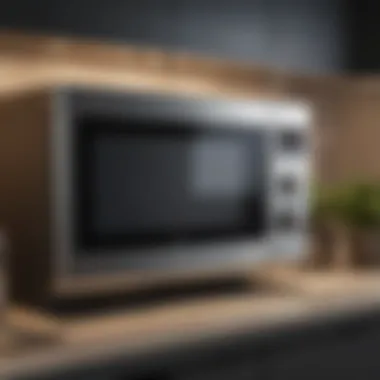Effective Methods for Cleaning the Inside of Your Microwave


Intro
Cleaning the inside of a microwave is often overlooked, but it should not be. Regular maintenance improves not only hygiene but also the appliance's efficiency. Over time, food splatters can accumulate and create an undesirable odor. In this article, we will explore various effective methods for cleaning your microwave, covering cleaning tools, products, and step-by-step instructions. Additionally, preventative measures will be discussed to keep your microwave in optimal condition.
Importance of Cleanliness
Maintaining cleanliness in your microwave holds significant importance. Food residues can become breeding grounds for bacteria. Moreover, a dirty microwave can hinder cooking performance. The longer stains and residue sit, the harder they are to remove. Regular cleaning prevents build-up and ensures the appliance functions effectively, promoting both health and convenience in food preparation.
Tools and Products for Cleaning
When it comes to cleaning a microwave, the right tools and products can make the task easier. Here is a list of commonly used items:
- Microfiber Cloths: These are great for wiping down surfaces without scratching.
- Sponges: Choose soft, non-abrasive sponges to scrub stubborn stains.
- Baking Soda: A natural cleaner known for its deodorizing properties.
- White Vinegar: Effective for cutting through grease and odors.
- Dish Soap: Helps to create a soapy mixture for deeper clean.
Step-by-Step Cleaning Instructions
Clean your microwave effectively by following these steps:
- Unplug the Microwave: Safety first. Always unplug the microwave before cleaning.
- Remove Turntable and Accessories: Take out the turntable and any other removable parts.
- Soak in Soapy Water: Soak these items in soapy water while you clean the interior.
- Prepare a Cleaning Solution: Mix equal parts of white vinegar and water in a microwave-safe bowl.
- Heat the Solution: Place the bowl in the microwave and heat on high for about 5 minutes. The steam will loosen grime.
- Wipe Down the Interior: Use the microfiber cloth to wipe all surfaces inside the microwave.
- Scrub Stubborn Spots: Use a sponge and the baking soda for tough stains. Apply gently.
- Rinse and Dry: Rinse the turntable and accessories. Dry everything thoroughly.
- Reassemble the Microwave: Once everything is clean and dry, place the turntable and accessories back in.
Preventative Measures
To keep your microwave in good condition, consider these tips:
- Cover Foods: Use microwave-safe lids or covers to prevent splatters.
- Wipe After Use: A quick wipe after each use can prevent build-up.
- Schedule Regular Cleanings: Set a reminder to clean your microwave at least once a month.
"Regular maintenance and cleanliness can prolong the life of your microwave."
With the right methods, you can achieve a clean and efficient microwave. By integrating these practices into your routine, you contribute to a healthier kitchen environment.
Prelims to Microwave Maintenance
Maintaining a microwave is essential not only for hygiene but also for the overall efficiency of the appliance. When food is heated in a microwave, spills and splatters can occur. These residues can create a breeding ground for bacteria, which underlines the importance of a clean environment. Moreover, accumulated grime can impede the microwave's operation, leading to uneven heating and potentially shortening its lifespan.
Ensuring regular cleaning routines protects the appliance's functionality. A neglected microwave may require more intense cleaning efforts, which can be time-consuming. Therefore, implementing a maintenance schedule is key to keeping your cooking appliance working efficiently.
In this article, we will delve into effective methods for cleaning the interior of your microwave, providing practical insights that cater specifically to homeowners, interior design enthusiasts, and others who prioritize clean and functional kitchens. The following sections will equip you with knowledge on how to maintain a clean microwave, the benefits of doing so, and the appropriate frequency for cleaning.
Understanding Microwave Components
Understanding the components of a microwave is crucial for effective cleaning. Each part plays a significant role in how the microwave functions, and knowing these parts can help in addressing cleanliness issues efficiently. A clean microwave is key for various reasons, such as ensuring food is heated evenly and preventing odors that can seep into future meals. Moreover, regular cleaning can enhance the appliance's lifespan, ultimately saving you costs on repairs or replacements.


Interior Surfaces
The interior surfaces of the microwave include the walls, ceiling, and floor. These areas are often exposed to splatters and stains from cooking processes. The material in most modern microwaves is designed to be easy to clean, but food particles can adhere stubbornly if not addressed promptly.
When cleaning these surfaces, a non-abrasive cleaner is advisable to prevent scratches. Using a solution of vinegar or baking soda can effectively break down grease and grime. Regular cleaning of these surfaces not only maintains hygiene but also ensures the appliance operates efficiently. It is vital to follow the manufacturer's guidelines regarding cleaning methods to avoid damaging the microwave's finish.
Turntable and Support
The turntable and its support are critical for even cooking. Food must rotate uniformly to ensure it heats through properly. Over time, both the turntable and the support can collect food residues. Therefore, these components require specific cleaning attention.
To clean the turntable, remove it from the microwave and wash it with warm soapy water. For tougher stains, a mixture of baking soda and water can be applied to form a paste that can be scrubbed gently. The support can usually be wiped down with a damp cloth. Ensuring these components are clean will enhance the overall cooking efficiency of the microwave.
Ventilation System
The ventilation system in a microwave is essential for maintaining airflow. It helps prevent overheating and ensures that cooking odors do not linger. If the ventilation system is blocked with grease or debris, it can lead to inefficient performance and possible malfunctions.
Cleaning the ventilation system typically involves removing any accessible filters and washing them according to the manufacturer's instructions. A mixture of vinegar and water can work effectively here. Regular maintenance of this component ensures that your microwave operates smoothly and efficiently.
Regular cleaning keeps your microwave operating at its best. Products like vinegar, baking soda, and proper tools are essential for maintaining cleanliness and efficiency.
Cleaning Solutions and Tools
Cleaning solutions and tools play a crucial role in maintaining the cleanliness of your microwave. Without proper cleaning agents, grease, food particles, and odors can accumulate over time. This not only compromises the hygiene but also the efficiency of the appliance. Using the right solutions ensures thorough cleaning without damaging internal components. It is essential to consider both natural and commercial options for diverse cleaning needs.
Natural Cleaning Agents
Natural cleaning agents offer an eco-friendly alternative for removing grime from the microwave interior. These agents are generally safe for household use and do not contain harsh chemicals.
Lemon Juice
Lemon juice is a potent natural cleaner due to its acidic properties. It effectively cuts through grease and has antibacterial qualities. The fresh scent of lemon also helps neutralize odors within the microwave. Its primary characteristic is its natural acidity which assists in breaking down tough stains. One of the key advantages of using lemon juice is that it is readily available and inexpensive. However, it is important to ensure that it is properly diluted before application to prevent potential damage to surfaces.
Baking Soda
Baking soda is widely praised for its cleaning capabilities. Its most notable characteristic is its mild abrasiveness, which allows it to scrub surfaces without scratching. When mixed with water, it forms a paste that can help lift stubborn stains effectively. The unique feature of baking soda is that it also deodorizes, eliminating unpleasant smells. Though generally safe, excessive use can leave a residue that may require rinsing. Thus, a moderate application is recommended, making it an ideal choice for maintaining microwave cleanliness.
Vinegar
Vinegar stands out as a versatile cleaning agent. Its principal contribution to the cleaning process is its acidity, which dissolves mineral deposits and cuts through grime. Vinegar is particularly beneficial for steaming, as it can be heated in the microwave to loosen stuck-on food particles. The strong smell of vinegar is often considered a disadvantage, but it dissipates quickly, leaving surfaces clean. The balance of effectiveness and accessibility makes vinegar a staple in many households.
Commercial Products
In contrast to natural cleaning solutions, commercial products offer specialized cleaning features that can be more effective in certain situations. These products are designed specifically for microwave cleaning, ensuring efficient results.


Microwave Cleaning Wipes
Microwave cleaning wipes are convenient for quick touch-ups. They come pre-moistened with cleaning solution, simplifying the process of maintaining cleanliness. The key characteristic of these wipes is their ease of use; they can be stored in a kitchen drawer and used as needed. The major advantage of microwave cleaning wipes is that they are portable and provide quick results. However, over-reliance on wipes might not effectively address deeper stains and buildup.
Aerosol Cleaners
Aerosol cleaners can provide a fast and powerful option for removing stains and grease from microwave surfaces. The spray format allows for even coverage and targeted application on problem areas. A significant benefit of aerosol cleaners is their strength; they can break down stubborn residues effectively. However, caution is advised concerning the chemicals used in these products. It is essential to follow usage instructions carefully to avoid damaging the microwave's interior or leaving behind harmful residues.
Essential Cleaning Tools
The right cleaning tools enhance the effectiveness of your cleaning solutions. Good tools enable thorough cleaning without causing damage to the appliance, ensuring that each area is properly addressed.
Microfiber Cloths
Microfiber cloths are impressive for their ability to capture dust and dirt without scratching surfaces. Their soft texture allows for gentle cleaning, making them ideal for use on the microwave's interior. The unique feature of microfiber is its ability to trap particles, providing a deep clean. Microfiber cloths are also machine washable, making them a sustainable choice. One downside is they may wear out over time, requiring periodic replacement.
Sponge
Sponge is another essential tool for cleaning the microwave. Its primary purpose is to apply gentle pressure on surfaces to dislodge food particles. Different textures are available, allowing you to choose the right sponge for the job. The key advantage of using a sponge is its capacity for flexibility, allowing it to reach awkward corners and crevices in your microwave. However, sponges can harbor bacteria if not cleaned or replaced regularly.
Scrub Brush
A scrub brush can be effective for tougher stains in the microwave. The bristles provide enough strength to scrub away grime without damaging the surface. The key advantage of using a scrub brush is its ability to tackle stubborn buildup in less accessible areas. Nonetheless, care must be taken as excessive scrubbing can lead to scratches. Proper technique and gentle use are essential to avoid damaging the microwave during the cleaning process.
Step-by-Step Cleaning Instructions
Cleaning the inside of your microwave is essential for maintaining both hygiene and performance. Regular cleaning prevents the build-up of food splatters, odors, and bacteria. The following step-by-step instructions will guide you through the process, ensuring a thorough and effective clean while taking note of specific elements and considerations.
Preparing the Microwave
Before beginning the cleaning process, it is crucial to prepare the microwave properly. First, turn off the microwave and unplug it from the power source. This enhances safety and prevents any accidental activation during cleaning. Next, remove any utensils or food items that may be inside, clearing the space for access to all surfaces. It can be beneficial to allow the microwave to cool down if it was recently used, as heat can make cleaning more difficult. Finally, gather all necessary cleaning supplies, including chosen cleaning solutions, cloths, and scrub brushes.
Cleaning the Interior Walls
The interior walls of the microwave often collect spots and stains from food spills. To clean these surfaces, use a damp cloth or sponge with a suitable cleaning solution. For natural options, a mixture of vinegar and water works well. Wipe down the walls systematically, starting from the top and moving downwards to avoid dripping cleaner onto already cleaned areas. Make sure to pay attention to the corners where food particles may accumulate. Rinse the cloth frequently and dry the surfaces with a clean, dry cloth or paper towel for best results.
Cleaning the Turntable
The turntable and its support also require attention. To clean them, remove the turntable from the microwave. Wash it with warm, soapy water or a mixture of baking soda and water for stubborn grease. If the turntable is dishwasher safe, you can place it in the dishwasher, following your model's guidelines. Make sure to clean the support ring underneath as well, using a soft cloth or sponge. Ensure everything is dried thoroughly before reassembling. This small step can help ensure that the microwave operates smoothly and does not have crumbs rolling around.
Addressing Stubborn Stains
Sometimes, even after regular cleaning, stubborn stains remain. For these tough spots, create a paste using baking soda and water, applying it directly to the stain and letting it sit for about 10-15 minutes. After this, scrub gently with a soft brush or non-abrasive sponge and rinse with a cloth dampened with plain water. If the stains persist, consider employing a commercial microwave cleaner while following the manufacturer’s instructions. Always conduct a spot test on a small area first to ensure there is no damage to the interior surfaces.


Finishing Touches
Once the cleaning is complete, ensure the microwave is dry before plugging it back in. To prevent odors, place a bowl of activated charcoal or a few slices of lemon inside for a short period. This can freshen the air within the appliance. Additionally, check the ventilation system for dust or debris, as these can affect performance over time. Finally, replace any accessories, ensuring that everything is positioned correctly. A clean microwave not only functions better but will also extend its lifespan.
"A thorough cleaning routine can enhance the efficiency and longevity of your microwave appliance."
Following these detailed steps will help you maintain a clean and efficient microwave, ensuring a pleasant cooking experience. Regular cleaning can lead to noticeable improvements in appliance performance and hygiene.
Preventing Future Build-up
Maintaining a clean microwave is not just about the immediate cleaning task. It’s also essential to employ strategies that prevent a buildup of grime and residue. Regular prevention measures can save time and effort on deep cleanings later. Not only does it make the microwave easier to clean, but it also enhances its efficiency and safety. By controlling messes before they become significant issues, homeowners can maintain a healthy kitchen environment.
Covering Food While Heating
One effective measure to prevent messes is to cover food while heating. Using a microwave-safe lid or plate can stop splatters from making contact with the microwave's interior surfaces. This simple action can significantly reduce the stains and stuck-on food particles that often necessitate vigorous cleaning.
Here are some material choices for covering food:
- Microwave-safe lids: These are designed to fit snugly, preventing steam from escaping while also avoiding unnecessary splatter.
- Paper towels: A single layer can absorb moisture and minimize mess.
- Microwave-safe plastic wrap: Ensure it is labeled as safe for microwave use to avoid melting or leaching chemicals.
Regular Maintenance Schedule
Establishing a regular maintenance schedule is crucial for keeping the microwave clean. Designating specific times for quick cleaning can be very effective. A weekly wipe down of the interior after use can prevent the accumulation of food debris. Here are some tips to consider:
- Choose a specific day: Pick one day a week to inspect and clean the microwave.
- Incorporate it into routines: Make cleaning part of other kitchen tasks, such as after meal prep.
- Keep cleaning supplies handy: Have necessary tools, such as wipes or sprays, easily accessible. This ensures that convenience becomes a motivating factor.
Storage Tips for Food
How food is stored can greatly influence microwave cleanliness. Improperly stored food can lead to leakage and spills. To mitigate this, consider these approaches:
- Use airtight containers: These help contain spills and maintain freshness.
- Seal leftovers and cover dishes: This will help in retaining moisture while preventing any mess in the microwave.
- Avoid plastic containers that are not microwave-safe: Always check labels to ensure safety and compatibility with microwave heating.
Consistent preventative measures can lead to significant time savings in maintaining your microwave's cleanliness.
The End
Cleaning the inside of your microwave is crucial for maintaining both its functionality and your health. A clean microwave not only ensures that food is heated evenly but also prevents unwanted odors and the growth of bacteria. Neglecting this appliance can lead to reduced efficiency and a shorter lifespan. Thus, it is essential to prioritize cleanliness as part of your routine household maintenance.
Summary of Best Practices
- Regular Cleaning: Aim to clean your microwave at least once every few weeks. This prevents stubborn stains and odors from developing.
- Use Natural Cleaners: Consider using lemon juice, baking soda, or vinegar, which are effective and safe cleaning agents. They do not contain harmful chemicals and are environmentally friendly.
- Cover Your Food: When heating items, use a microwave-safe cover to avoid splatters, which can make cleaning easier.
- Thoroughly Clean After Spills: Whenever there is a spill, clean it immediately. This minimizes the risk of stains and unpleasant smells.
By adhering to these best practices, you can keep your microwave looking and functioning at its best.
Long-term Benefits of Clean Appliances
Maintaining a clean microwave provides several long-term advantages.
- Improved Hygiene: A clean environment reduces the risk of foodborne illnesses. Regular cleaning ensures that harmful bacteria do not breed.
- Increased Efficiency: A microwave functions better when it is clean. Food that splatters can create hot spots, which diminishes heating consistency.
- Cost Efficiency: Keeping appliances clean extends their lifespan. Regular maintenance can prevent costly repairs or replacements in the future.







